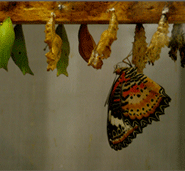Enter a white cube: Sterile. Sombre. Spotless, shadow-less. Sedentary, Sparse. Object after object neatly perched on a pedestal or framed and suspended from nails on pristine white walls. The square space interpellates you into the materialist system of the evaluation of art objects against a monetary value. The endless reproduction of artwork through various media allows Art to be commoditised; it's value in the art market far exceeding its value as a unique/singular experience.
Railing against commodity-fetishism in the art market is a former student of Economics, now conceptual artist, Tino Sehgal. Unlike those who eschew gallery and museum spaces to stage their dissent, he situates himself within the white cube and makes it wear itself inside out. He de-objectifies the gallery space and builds into the character of his work all that is prohibited in a museum space. Thus, the artist critiques the structure of the white cube from within, acquires a place inside the system to critique its materialism and code.
Sehgal creates art that celebrates its own ephemeral quality and a shared temporality between the audience and the art (whose distinctions are often blurry). However he does not identify with the nomenclature, “performance artist”, and resists being slotted in the genre of theatre. With no starting or end points, they do not qualify as theatrical performances. Instead, he deems his work “living sculptures”, utilizing the malleable clay of human bodies to sculpt out his concept.
In Sehgal's, This Situation, which was recently performed at Goethe-Institute in Delhi, just as I entered the room, the 'interpreters' (Sehgal resents them being called 'actors') chorused 'Welcome to this situation' and take in a slow, sharp and sonorous breath in. They disperse to different corners of the room contort their bodies into frozen positions. Then one of them recited a philosophical maxim pre-chosen by Sehgal, that begins like this - 'In 1957, somebody said...'. The interpreters responded to it as and when they wanted to. Sometimes agreeing with each other, sometimes countering the other person's argument in calm and controlled, almost monotone. The dialogue and discussion was spontaneous and unrehearsed. Every time someone new entered, they welcomed them to a new situation- a new maxim on morality, economics or a sociological theme. Sometimes a member of the audience would join in, expressing her opinion, sharing a personal experience. The discussions centred around advertisements, neo-colonialism, desire, ageing and the idea of beauty. The poses they struck were meant to imitate famous works of art. These almost farcical imitations of great works of art teamed with an intellectual discussion about the economics of life seemed to mock the high-brow, inaccessibility of the stocks of galleries and museums.
The distinct aspect of Sehgal is that he does not allow his work to be documented through video or photography. His aim to produce pieces that can never be replaced as they were lived out has a political agenda. He feels a glut of material art, which makes art objects to be possessed rather than experienced. However, his own ideology turns inside out, just as the white cube does: This very anti-consumerist art gets exchanged for tangible currency running into six figures. Sehgal sells his idea; there being no marble sculpture or canvas to exchange for money, He sells his art through a ritual that tries to escape material evidence of the exchange. In order to sell his idea and the right to enact it, he engages in a verbal contract with the buyer in the presence of a notary. The questions that arise then are- Is Sehgal's 'holier than thou' disposition condemning a whitecubism, a hoax? Is he not profiting, and pretty richly for that, from the capitalist art market he claims to bestride? To me, the answer lies in participating in Sehgal's artwork. What the artist astutely accomplishes is the denial of an individual to own the work as her personal property, even when it is exchanged for money by one. An individual can never be in possession of his work. The only access to his art is shared, communitarian, ephemeral and experiential.
The artist defies the inertness and sanctimony of the white cube. Sehgal's art leaves behind no residue or even a tactile souvenir to take home, not even a concept note on a piece of paper. His art lives itself out in a particular space and time, never to be reproduced exactly. Rather than create objects, in a deliriously materialistic cultural milieu, he creates encounters that each spectator can have ownership over, in the reels of memory.
Manjari Kaul is a Delhi-based independent Art writer who annotates and ruminates over new ways of looking at contemporary Indian art and cinema.
Tino Sehgal was born in 1976, and is based in Berlin.
Editor's Note.
I was about 9 years old—a 3x3 cube—and my school had a class, an hour a week, called 'Value Education'. Our teacher gave us an A4 sheet of paper, split into 12 boxes. Each box had a patternless constellation of dots. Our task was simply to create a square, a rectangle or a triangle within each box, without leaving a single dot astray.
While I connected the dots into stars and baby elephants with stubbed noses and large antennae, my peers were coerced—I say coerced because it was a time when lines did not come naturally to us, when we didn't feel obliged to color inside trees and they didn't need to be green—into following the structure.
Read MoreWhile I connected the dots into stars and baby elephants with stubbed noses and large antennae, my peers were coerced—I say coerced because it was a time when lines did not come naturally to us, when we didn't feel obliged to color inside trees and they didn't need to be green—into following the structure.
Also in this issue
Illusion: Seeing Beyond Seeing
Meaning: In Search of Significance.
Melody: A Different Tune
Rhythm: Ordering Time









